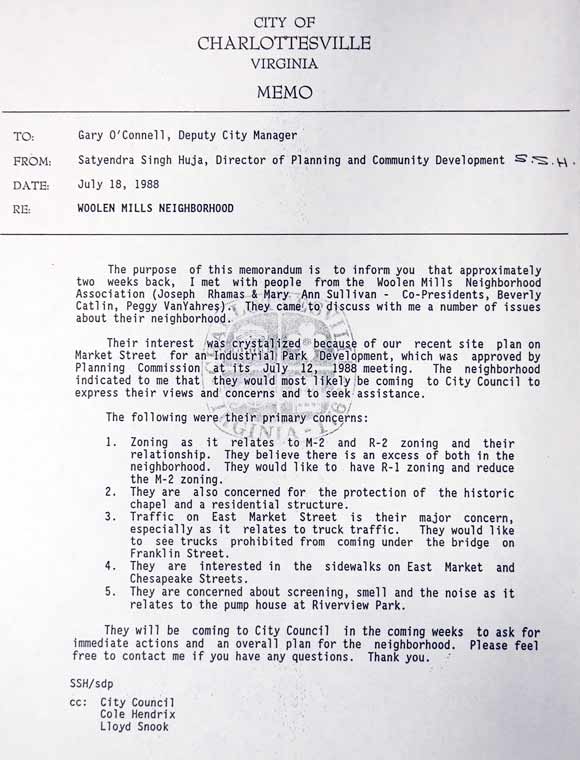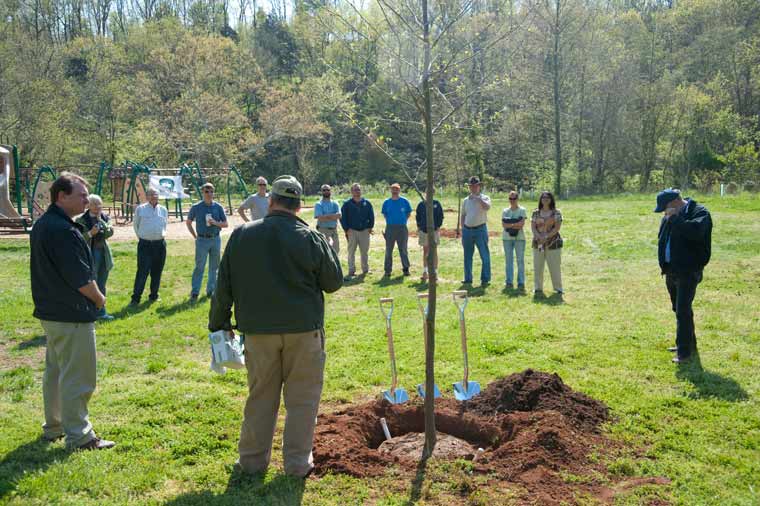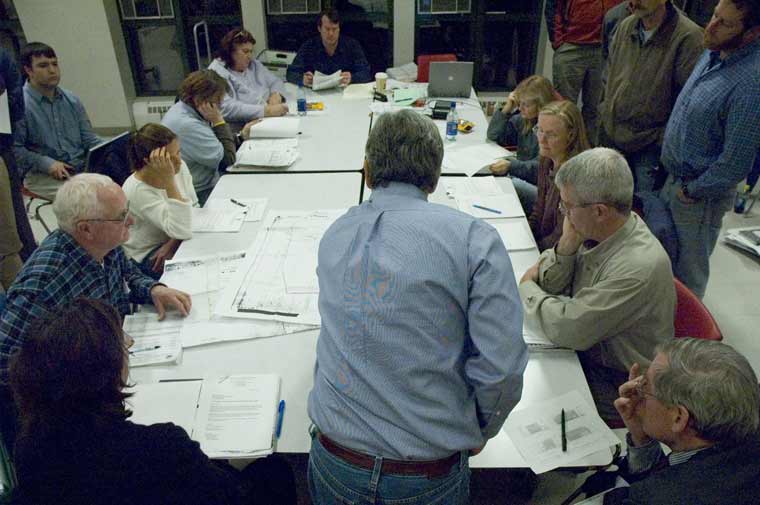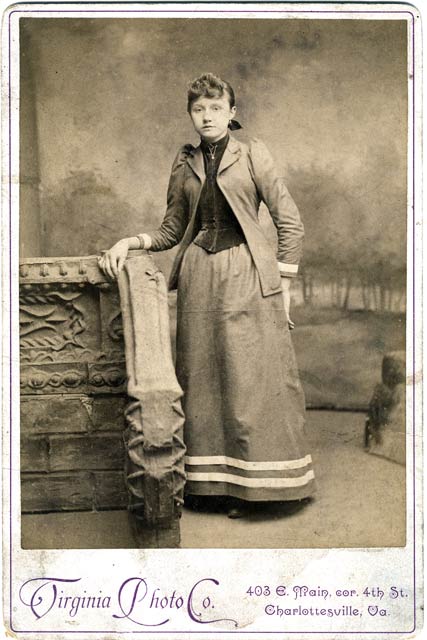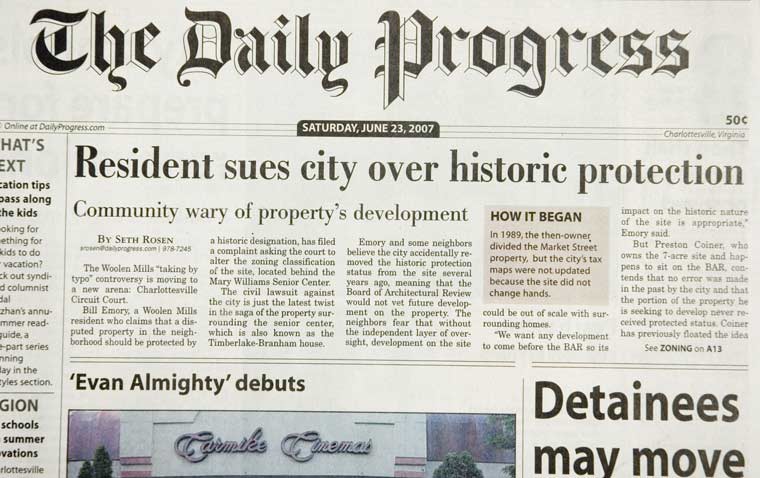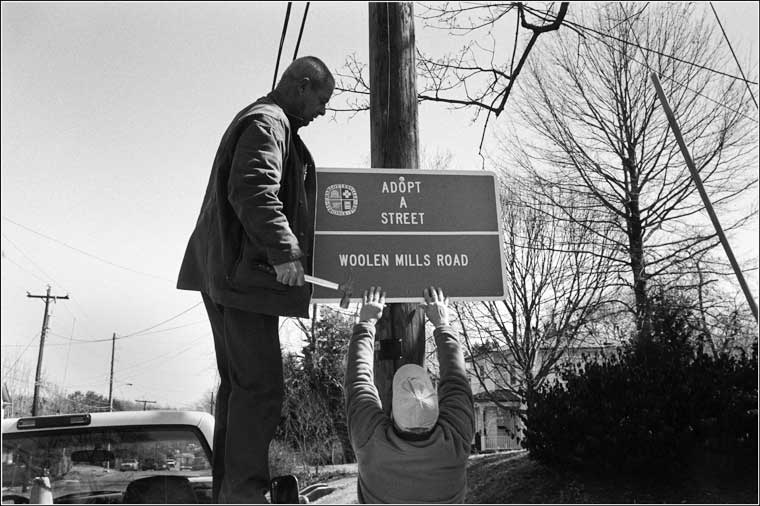 (left to right, dais) Van Yahres, Gilliam, Hendrix, Barbour, Wiley, Rinehart, Fife, (foreground) Ewert, Rush-- photo by Rip Payne ca. 1975
(left to right, dais) Van Yahres, Gilliam, Hendrix, Barbour, Wiley, Rinehart, Fife, (foreground) Ewert, Rush-- photo by Rip Payne ca. 1975Mayor Charles L. Barbour
Charlottesville, Virginia 22902
June 2, 2008
Charlottesville City Council
Charlottesville Planning Commission
Board of Architectural Review
P.O. Box 911
Charlottesville, VA 22902
Dear Council, Planning Commission and B.A.R. members,
June 2, 2008 Council will consider initiating the rezoning of the historic Branham-Timberlake property in the Woolen Mills.
This case caught my attention, I have not studied the matter in depth but I recognize a pattern that I believe is worthy of a letter.
The Recreation precinct was one of my weaker precincts. In 1974 I received one in four votes cast in Recreation. But throughout my time on Council, my time as Mayor, we did our best for all the people of Charlottesville. We made significant progress, we made history. We upgraded transit, parks, housing, we approved and constructed the downtown mall, we built sidewalks. We sat in your chairs and did our best to serve all the people.
The Branham-Timberlake historic zoning issue needs your careful attention. This is a remaining piece of a larger equity issue, there is work to do.
We started the work in the 1970s. Neighborhoods are our homes, they are our place of refuge, neighborhoods deserve protection. When I first came to Council, there were no neighborhoods for Blacks. This was two years after the Civil Rights Act, the Fair Housing Act. When I say there were no neighborhoods for Blacks, I mean there were no Black neighborhoods zoned residential. There was no neighborhood in the inner city where a family was safe from a service station opening for business next door.
Zoning is a process designed to protect people and maintain the health of a living city. With zoning we make our people secure at home. We located pools and parks that could be reached safely by pedestrians. Working with the newly formed Department of Community Development and the neighborhood associations we pursued the goal of the common good.
Between 1970 and 1978 we called attention to the prejudice in the existing zoning and we labored mightily to fix it, working with Mr. Huja, to reconfigure the zoning map.
There are three things that protect a neighborhood.
1--Strong families, education and hard work protect a neighborhood. 2--Government process and services protect a neighborhood. 3--Wealth protects a neighborhood.
Through our efforts as a community, walking together, I believe these things are achievable, but we have miles to go.
Who would approve Manufacturing zoning in a residential neighborhood? Who would say that a six storey factory should be built next to a two storey home? Who would say the safe place for children to play is next to a concrete plant? There is work to be done.
Who applied Manufacturing zoning to residential neighborhoods? This is left over, segregation-times zoning. Segregation doesn't apply only to race, people are segregated by income as well.
In the 1970s we worked with CRHA to distribute housing throughout the city, to avoid isolating the poor in enclaves. We worked on the zoning map to create strong and secure neighborhoods, but there are still miles to go.
The pattern I recognize is the unequal protection of neighborhoods by the zoning map.
Ownership and property rights are important in our country. We don't take from a man what he has earned. But ownership isn't a license to abuse. Absentee ownership must walk hand in hand with stewardship, fairness, justice and equal protection. The small man must receive the same level of regard as the big man when he deals with the City, and the City must communicate with the neighborhoods.
Why is the Manufacturing zoning in Charlottesville located in less privileged neighborhoods? Because these neighborhoods were disenfranchised in the 1950s, there was a poll tax, these neighborhoods were not represented, they did not have champions in City Hall.
The fifties were a long time ago, but traces of the wrong done in those years remain. The peoples faith in the fair exercise of authority requires robust, consistent, transparent governance. This faith requires the evenhanded application of legislation. The peoples faith requires due-process.
This zoning caught my attention, this type of discriminatory zoning in residential areas is an old, familiar adversary.
I read that legislation passed by Council in 1993 to protect this historic property, was erased by accident, by a clerical error, or by the interpretation of staff. That cannot happen. If the process was not followed the protection was not lost.
Localities adopt zoning ordinances to ensure the orderly development and strengthening of community. Destruction of neighborhoods was once labeled as progress, let that thinking stay in the past.
We work towards unity, we fight for equal protection. Give your best effort to the people of Recreation, Carver, Clark, Tonsler, Walker, Alumni Hall, Venable, and Jefferson Park. Restoring order, equity and fairness to the zoning process is critical for all.
This matter is before Council tonight. I recommend that you move to correct the substantial reduction in size of the Branham-Timberlake I.P.P. between 1993 and 2003. Approve with a unanimous vote in favor of the Resolution, the general welfare and good zoning practice require no less.
In the coming weeks, the proposed rezoning will be before the Planning Commission and the B.A.R. for recommendations and then back before Council.
I urge you to work until the work is done.
Sincerely,
Charles L. Barbour
Member of Council, 1970-1978
Labels: government, Timberlake-Branham

